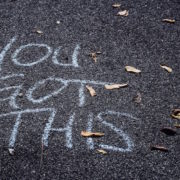POST-TRAUMATIC GROWTH: How to Build the Resilience of a Soldier in 5 Steps
Have you ever felt like you’ve been ‘smacked around’ by life?
Sometimes life throws you a curveball; something that knocks you for six, that makes you wonder whether life will ever be the same again…
It might be work-related or in your personal life, but a traumatic event can make you feel defeated, or rejected or helpless or completely shattered or a whole range of other things – like you’re riding a roller coaster of emotions and you can’t get off.
Exposure to traumatic events can lead to Post-Traumatic Stress Disorder (PTSD).
Several recent developments in the trauma field have led to significant changes in how PTSD is diagnosed and treated.
Martin Seligman has done some significant work in this area and has found from his research that people who had experienced particularly awful situations could experience what’s called Post-Traumatic Growth.
Seligman found that with the right support and a good process trauma doesn’t need to flatten us forever.
Martin Seligman’s been offering this type of support to the U.S. Army since 2009 via his Master Resilience Training.
In the video above, I’ll give you a snapshot of the 5 Steps for Building Resilience from this Master Resilience Training program.
For more practical ways to Build Resilience as a Leader, you can now enrol in this full-length course on Udemy, click here to claim a limited time discount.
[Prefer reading over videos? Video Transcription Below!]
5 Steps for Building the Resilience of an Army Soldier
Martin Seligman’s Master Resilience Training focuses on five key areas:
How to Build Resilience Step 1 – Build Mental Toughness
In the first step of the program, they use a range of techniques to tap into and reality check beliefs and thinking, and to learn mastery of thinking.
Because it’s your thinking that drives emotions and behaviour.

How to Build Resilience Step 2 – Fight Catastrophic Thoughts
The next strategy in the program is to help soldiers fight catastrophic thoughts in real-time.
After a trauma, it can be easy to get trapped by catastrophic thinking… which is constantly imagining and reliving the worst.
This can be a thinking habit that people who haven’t experienced trauma can get stuck in too, and it can be a real source of stress.
So to overcome this, soldiers are taught to follow three steps.
- Gather Evidence – check if the evidence backed up what they are thinking about a situation.
So, for example, if they were imagining that their partner was going to leave them while they’re away on duty, some evidence gathering included things like the fact that their partner had always replied to emails in the past and that because of their location overseas it usually took some time to hear back.
- Apply Optimistic Thinking – choosing the most positive lens to see the situation, instead of the most catastrophic.
This could include focusing on how good it will be to hear news from home when the email does arrive.
- Gain Perspective
To gain perspective, soldiers were encouraged to consider three things: the worst case, the best case, and the most likely case.
So the worst case in our example might’ve been that their partner was with someone else.
The best case might’ve been that their partner consistently shows their commitment to them.
And the most likely case could have been something like my partner is busy with the kids and their family and friends who are an important part of their support network.
So, this approach doesn’t assume that you replace every negative thought with a positive one. It’s designed as a stop-gap to short circuit catastrophic thinking so that a person can stay resourceful and not be overwhelmed by catastrophic thinking.
How to Build Resilience Step 3 – Hunt the Good Stuff
Soldiers were encouraged to keep a gratitude journal and each morning to write down three good things that had happened the day before.
To start with, the soldiers tended to focus on what was happening to them at work.
But over time, their good stuff also included details about personal events like phone calls home to their family and the good things that were happening there.
They found that they had started to listen more actively and pay more attention to positive experiences, which improved their relationships and their positive emotions.
How to Build Resilience Step 4 – Use Character Strengths
Participants in the program filled out the VIA character strengths survey.
We also use this survey within our Great Managers Academy training as there’s strong research that shows that when people know and use their strengths, they perform much better in all areas of their life.
Step 5 – Build Strong Relationships.
As you can imagine, personal and professional relationships are a source of a lot of challenges for people in the military.
They’re challenges for us in most workplaces as well.
The goal of this step of the training was to provide practical tools to build relationships and challenge the beliefs that might get in the way of positive communication.
Strong relationships are important for all of us.
Sheryl Sandberg in Option B talks about how important strong relationships are in helping us recover from setbacks.
We are hardwired to connect with others, but when we’re struggling, we can often pull away from others rather than connect in or ask for help.

Next Steps
In terms of results from this Master Resilience Training, since 2009, hundreds of thousands of U.S. soldiers have completed the program.
A 2013 evaluation showed that the program had resulted in:
- A reduction in the rates of mental health issues
- A reduction in the PTSD symptoms amongst soldiers
So in a tough environment like the military, these are some pretty powerful results for them, and these show that we can really work on our ability to recover, even from the toughest sorts of setbacks.
Note: If you’re interested in more detail around Seligman’s MRT program, you will find it in his book called Flourish.
If you would like to learn more ways to Build Resilience and Bounce Back from Setbacks, enrol in our Udemy course today. Click here for a limited time discount.







